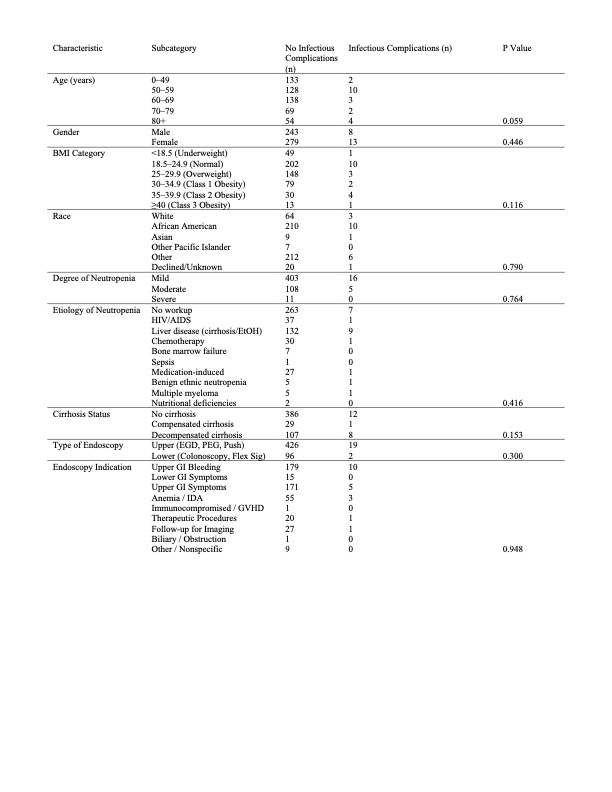Tuesday Poster Session
Category: General Endoscopy
P5137 - Rates of Infectious Complications in Neutropenic Patients Undergoing Endoscopy
Tuesday, October 28, 2025
10:30 AM - 4:00 PM PDT
Location: Exhibit Hall

Bishoy Gad, MD (he/him/his)
Montefiore Medical Center
Bronx, NY
Presenting Author(s)
Bishoy Gad, MD, Erica Chung, MD, Lewis J. Paulino, MD, Vasilios Koulouris, MD, Daniel Behin, MD
Montefiore Medical Center, Albert Einstein College of Medicine, Bronx, NY
Introduction: Infectious complications following endoscopic procedures occur rarely, but it is unclear if the risks are higher in neutropenic patients. Existing studies are few and show mixed results. In this study, we examine the rate of infectious adverse events in neutropenic patients undergoing endoscopic procedures and determine if the degree of neutropenia correlates with the risk of an infectious complication.
Methods: We performed a retrospective analysis of neutropenic patients who underwent inpatient endoscopy. Patients were stratified by severity of neutropenia based on the absolute neutrophil count (ANC): mild (1000-1500), moderate (500-999), or severe (< 500). An infectious complication was defined by the onset of new fever, bacteremia, or consolidation on chest x-ray (CXR) within 72 hours of endoscopy. Patients with known active infections or those already on antibiotics prior to endoscopy were excluded to minimize confounding. Charts were reviewed for severity and etiology of neutropenia, comorbid conditions, indication of procedure, and for any infectious complications. Multivariate regression and chi-squared subgroup analyses were performed.
Results: We identified 856 neutropenic patients who underwent endoscopy between June 2018 and September 2023, of whom 543 met the inclusion criteria. Of these, 21 patients developed an infectious complication following endoscopy: 19 with fever, 1 with bacteremia, and 5 with new consolidations on CXR. Most infectious complications occurred following upper endoscopy; however, this was not statistically significant. There was no statistically significant association between the degree of neutropenia and the risk of infectious complications. There was no significant difference in the rates of infectious complications between any of the subgroups as outlined in Figure 1.
Discussion: Infectious complications in neutropenic patients following endoscopy have not been well characterized. We found low rates of infectious complications in our patient population (~3.9%), with no significant association between complication rates and the degree of neutropenia, procedure type, indication, or comorbidities. These findings support the overall safety of endoscopy in this population, particularly when clinically indicated and preceded by a risk-benefit discussion. Given our limited sample size and retrospective design, larger prospective studies are needed to further validate the safety profile and guide procedural decision-making in this high-risk population.

Figure: Figure 1: Infectious complication rates of neutropenic patients by subgroup of demographics, comorbidity, procedure type, and procedure indication.
Disclosures:
Bishoy Gad indicated no relevant financial relationships.
Erica Chung indicated no relevant financial relationships.
Lewis Paulino indicated no relevant financial relationships.
Vasilios Koulouris indicated no relevant financial relationships.
Daniel Behin indicated no relevant financial relationships.
Bishoy Gad, MD, Erica Chung, MD, Lewis J. Paulino, MD, Vasilios Koulouris, MD, Daniel Behin, MD. P5137 - Rates of Infectious Complications in Neutropenic Patients Undergoing Endoscopy, ACG 2025 Annual Scientific Meeting Abstracts. Phoenix, AZ: American College of Gastroenterology.
Montefiore Medical Center, Albert Einstein College of Medicine, Bronx, NY
Introduction: Infectious complications following endoscopic procedures occur rarely, but it is unclear if the risks are higher in neutropenic patients. Existing studies are few and show mixed results. In this study, we examine the rate of infectious adverse events in neutropenic patients undergoing endoscopic procedures and determine if the degree of neutropenia correlates with the risk of an infectious complication.
Methods: We performed a retrospective analysis of neutropenic patients who underwent inpatient endoscopy. Patients were stratified by severity of neutropenia based on the absolute neutrophil count (ANC): mild (1000-1500), moderate (500-999), or severe (< 500). An infectious complication was defined by the onset of new fever, bacteremia, or consolidation on chest x-ray (CXR) within 72 hours of endoscopy. Patients with known active infections or those already on antibiotics prior to endoscopy were excluded to minimize confounding. Charts were reviewed for severity and etiology of neutropenia, comorbid conditions, indication of procedure, and for any infectious complications. Multivariate regression and chi-squared subgroup analyses were performed.
Results: We identified 856 neutropenic patients who underwent endoscopy between June 2018 and September 2023, of whom 543 met the inclusion criteria. Of these, 21 patients developed an infectious complication following endoscopy: 19 with fever, 1 with bacteremia, and 5 with new consolidations on CXR. Most infectious complications occurred following upper endoscopy; however, this was not statistically significant. There was no statistically significant association between the degree of neutropenia and the risk of infectious complications. There was no significant difference in the rates of infectious complications between any of the subgroups as outlined in Figure 1.
Discussion: Infectious complications in neutropenic patients following endoscopy have not been well characterized. We found low rates of infectious complications in our patient population (~3.9%), with no significant association between complication rates and the degree of neutropenia, procedure type, indication, or comorbidities. These findings support the overall safety of endoscopy in this population, particularly when clinically indicated and preceded by a risk-benefit discussion. Given our limited sample size and retrospective design, larger prospective studies are needed to further validate the safety profile and guide procedural decision-making in this high-risk population.

Figure: Figure 1: Infectious complication rates of neutropenic patients by subgroup of demographics, comorbidity, procedure type, and procedure indication.
Disclosures:
Bishoy Gad indicated no relevant financial relationships.
Erica Chung indicated no relevant financial relationships.
Lewis Paulino indicated no relevant financial relationships.
Vasilios Koulouris indicated no relevant financial relationships.
Daniel Behin indicated no relevant financial relationships.
Bishoy Gad, MD, Erica Chung, MD, Lewis J. Paulino, MD, Vasilios Koulouris, MD, Daniel Behin, MD. P5137 - Rates of Infectious Complications in Neutropenic Patients Undergoing Endoscopy, ACG 2025 Annual Scientific Meeting Abstracts. Phoenix, AZ: American College of Gastroenterology.
